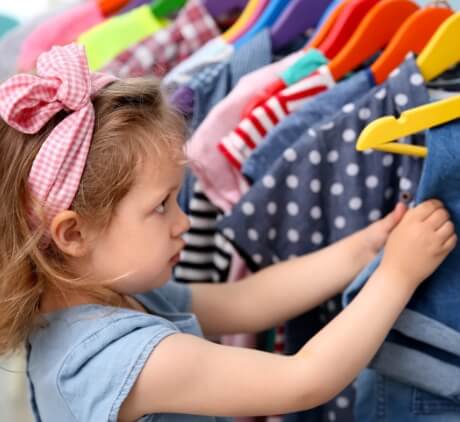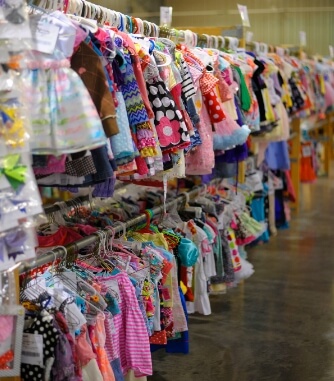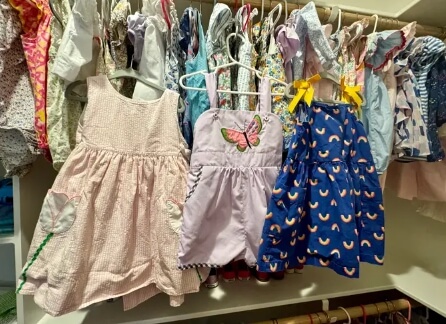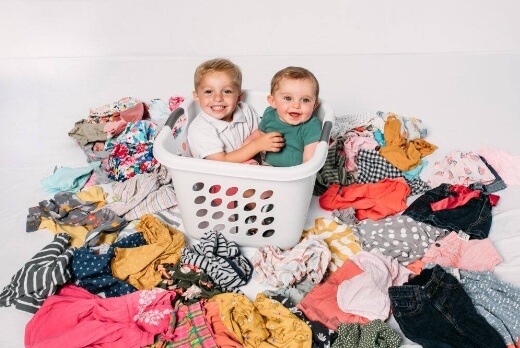Why Pre-Loved Children’s Apparel is Gaining Momentum in Today’s Market
The concept of pre-loved children’s apparel has rapidly evolved, transitioning from niche markets to mainstream acceptance. As children outgrow clothes quickly, parents are finding value in buying gently used, high-quality items at a fraction of the cost. This trend not only offers a practical solution for families but also reflects a broader movement toward sustainability in the fashion industry, with secondhand kids’ clothing at the forefront.

Introduction: The Growing Popularity of Pre-Loved Children’s Apparel
In recent years, the growing popularity of secondhand kids’ clothing has reshaped the way parents approach shopping for their children’s wardrobes. As families become more environmentally conscious and seek cost-effective solutions, pre-loved children’s apparel has emerged as a practical alternative to buying new. Not only does it offer significant savings, but it also allows parents to contribute to a more sustainable fashion cycle by reducing textile waste. With more options available online and in local stores, secondhand kids’ clothing has transitioned from a niche market to a mainstream choice, appealing to both eco-minded and budget-conscious parents.
Overview of the shift toward secondhand kids’ clothing
The shift toward secondhand kids’ clothing has been driven by changing consumer attitudes around sustainability and financial practicality. As parents become more aware of the environmental impact of fast fashion, they are increasingly choosing pre-loved children’s apparel as a way to minimize waste and extend the lifecycle of clothing. What was once considered a niche practice has now gained mainstream acceptance, with families seeing the value in purchasing high-quality, gently used items at a fraction of the cost of new ones. This growing trend is reshaping the children’s fashion market, making secondhand an attractive option for modern parents.
Factors driving the demand for pre-loved children’s clothing
Several key factors are fueling the demand for pre-loved children’s apparel. First, the rapid pace at which children outgrow their clothes makes secondhand kids’ clothing a more practical and economical choice for many families. Additionally, growing environmental awareness has led parents to seek out more sustainable fashion options, making secondhand items an appealing way to reduce their carbon footprint. Finally, the rise of online marketplaces has made it easier than ever for parents to access a wide variety of affordable, high-quality pre-loved children’s apparel, further boosting the demand in this sector.
Why Parents are Choosing Pre-Loved Over New
Parents are increasingly choosing pre-loved children’s apparel over new for a variety of reasons, with affordability being a primary factor. Secondhand kids’ clothing allows families to dress their children in stylish, high-quality garments at a fraction of the cost of new items. Additionally, with children quickly outgrowing their clothes, buying pre-loved makes financial sense, as parents can often find barely worn pieces in excellent condition. Beyond cost savings, many parents are motivated by the environmental benefits, as opting for secondhand reduces waste and supports more sustainable consumption. This combination of practicality and eco-consciousness is driving the growing preference for secondhand kids’ clothing.

Affordability and value of secondhand kids’ clothing
For many parents, the affordability of secondhand kids’ clothing is a key reason for choosing pre-loved over new. With children rapidly outgrowing their clothes, constantly purchasing new items can become an expensive endeavor. Secondhand kids’ clothing offers a budget-friendly solution, allowing families to save money while still providing their children with stylish and practical attire. By choosing pre-loved children’s apparel, parents can often find high-quality, gently worn pieces at a fraction of the original price, maximizing value without sacrificing style or comfort.
Quality and durability of pre-loved children’s apparel
One of the surprising advantages of pre-loved children’s apparel is the high quality and durability of many secondhand items. Since children’s clothing is often outgrown before it’s worn out, parents can find secondhand kids’ clothing in excellent condition. Many pre-loved pieces, especially from reputable brands, are made to last and can withstand multiple owners. This durability ensures that secondhand clothing remains a reliable choice, providing long-lasting wear for new children without compromising on quality or style.
The Role of Sustainability in the Secondhand Kids’ Clothing Boom
Sustainability plays a crucial role in the booming popularity of secondhand kids’ clothing, as more parents recognize the environmental impact of their purchasing decisions. By opting for pre-loved children’s apparel, families are actively participating in a more sustainable fashion ecosystem that reduces waste and minimizes their carbon footprint. The fast fashion industry contributes significantly to environmental degradation, and choosing secondhand kids’ clothing helps combat this issue by extending the lifecycle of garments. As awareness of sustainability grows, many parents are proud to support eco-friendly practices while still dressing their children in fashionable and high-quality items, making secondhand options increasingly appealing.
Environmental benefits of choosing secondhand clothing
Choosing secondhand kids’ clothing offers significant environmental benefits, making it an attractive option for eco-conscious parents. The fashion industry is a major contributor to pollution and resource depletion, but purchasing pre-loved children’s apparel helps reduce the demand for new clothing production. This decrease in manufacturing leads to less water usage, fewer chemicals released into the environment, and a reduction in energy consumption. By choosing secondhand, parents not only save money but also contribute to a greener planet by lessening their environmental impact.
Reducing textile waste and carbon footprint through secondhand purchases
One of the most impactful ways to reduce textile waste and carbon footprint is by purchasing secondhand kids’ clothing. Every year, tons of clothing end up in landfills, contributing to pollution and wasted resources. By buying pre-loved children’s apparel, parents extend the life of garments that would otherwise be discarded. This shift reduces the need for producing new items, which in turn lowers the carbon emissions associated with manufacturing and shipping. Secondhand clothing helps close the loop in fashion, promoting reuse and reducing waste on a global scale.
Online Marketplaces vs. Local Shops: Where to Buy Pre-Loved Children’s Apparel
When it comes to buying pre-loved children’s apparel, parents today have more options than ever, with both online marketplaces and local shops offering a wide range of secondhand kids’ clothing. Online platforms provide convenience and access to a vast selection of styles, brands, and sizes from the comfort of home, making it easier for parents to find the perfect items for their children. On the other hand, local thrift stores and consignment shops allow families to inspect clothing in person and support their community by shopping locally. Both options offer affordable, sustainable alternatives to buying new, making secondhand kids’ clothing an accessible and eco-friendly choice for parents everywhere.

Popular online platforms for secondhand kids’ clothing
There are numerous popular online platforms dedicated to secondhand kids’ clothing, providing parents with easy access to a wide variety of pre-loved children’s apparel. Websites like Poshmark, ThredUp, and Kidizen specialize in gently used clothing, allowing users to browse through countless listings, filter by size and style, and find high-quality items at affordable prices. These platforms often include features like user reviews and ratings, ensuring that buyers can make informed decisions about their purchases. With the convenience of shipping directly to their homes, parents can effortlessly shop for secondhand kids’ clothing from anywhere, making it a popular choice in today’s digital age.
Pros and cons of shopping online vs. locally for pre-loved children’s items
When it comes to buying pre-loved children’s apparel, both online and local shopping options have their pros and cons. Shopping online offers the convenience of a wider selection and the ability to compare prices easily, making it a time-saving option for busy parents. However, it may lack the tactile experience of inspecting items in person, which can be crucial when assessing the quality of secondhand kids’ clothing. On the other hand, local shops allow parents to physically try on items and ensure they are in good condition, but their inventory may be limited compared to online options. Ultimately, the choice between online and local shopping for pre-loved children’s items depends on individual preferences and needs, balancing convenience with the desire for quality and sustainability.
How Secondhand Kids’ Clothing Supports Circular Fashion
Secondhand kids’ clothing plays a vital role in supporting the concept of circular fashion, which emphasizes the reuse and recycling of garments to minimize waste. By choosing pre-loved children’s apparel, parents not only extend the lifecycle of clothing but also contribute to a more sustainable fashion ecosystem. Circular fashion encourages the idea that clothing should be valued beyond its initial purchase; when families buy and sell secondhand kids’ clothing, they help create a cycle where garments are continuously passed on and reused. This approach reduces the demand for new production, conserves resources, and lessens environmental impact, making the choice of pre-loved items a responsible and eco-friendly decision for today’s families.

The concept of circular fashion and its application in children’s apparel
Circular fashion is an innovative approach that seeks to redefine the life cycle of clothing by promoting sustainability through reuse and recycling. In the context of children’s apparel, this concept is particularly relevant, as kids grow quickly and often outgrow their clothes before they show significant signs of wear. Secondhand kids’ clothing exemplifies circular fashion by allowing these garments to be reused and enjoyed by new families. By prioritizing pre-loved children’s apparel, parents can actively participate in a system that values longevity and minimizes waste, fostering a more sustainable future for the fashion industry.
How the secondhand market encourages reuse and recycling of children’s clothes
The secondhand market plays a crucial role in encouraging the reuse and recycling of children’s clothes, creating a cycle that benefits both the environment and families. When parents choose secondhand kids’ clothing, they not only save money but also help keep garments in circulation, reducing the demand for new production. This market facilitates the exchange of pre-loved children’s apparel through consignment shops, online platforms, and community events, making it easy for families to buy, sell, and trade items. By supporting this system, parents contribute to a culture of sustainability that values the life of each piece of clothing, promoting environmental responsibility and economic savings.
Conclusion: The Future of Pre-Loved Children’s Apparel
The future of pre-loved children’s apparel looks promising as more parents recognize the numerous benefits associated with secondhand kids’ clothing. As the demand for sustainable fashion continues to rise, the secondhand market is likely to expand, offering even more options for families seeking affordable, high-quality garments. With increasing awareness of environmental issues and the desire for budget-friendly solutions, parents are embracing pre-loved children’s apparel as a viable alternative to fast fashion. This trend not only supports the well-being of the planet but also fosters a sense of community as families connect through the exchange of gently used items. Ultimately, the growing acceptance of secondhand kids’ clothing indicates a shift toward a more sustainable and conscious approach to children’s fashion.






